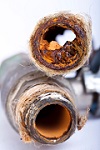
More Lead in the Water?Friday, July 24, 2015 - by Water2Drink
Lead contamination in drinking water is still a concern to some
U.S. citizens, and if it’s not, it should be. A new study, “Lead Release to
Drinking Water from Galvanized Steel Pipe Coatings,” (Brandi Clark, Sheldon
Vaughn Masters, and Marc Edwards, #VirginiaTech, Blacksburg, VA,) reveals that
galvanized steel pipe is being demonstrated as a source of lead contamination
in drinking water. The study can be accessed for free until Aug. 22, 2015, on
the Environmental Engineering Science website. Galvanized pipe is a steel pipe that is covered with a protective
layer of zinc. This type of pipe was installed as water lines in many homes
built in the last century. Over time, zinc erodes from the galvanized pipe, allowing
corrosion to build up on the inside of the pipe, resulting in the potential for
lead accumulation and contamination.
While consumers may have had water lines replaced in their
home, #galvanizedpipes may still exist outside the home; therefore, consumers
are susceptible to lead contamination between the municipal water source and
their home.
The only way to prevent lead contamination in your drinking
water is to use a point-of-use drinking water filter that is NSF-tested and
certified for lead reduction. Boiling water does not reduce lead levels, nor do
pitcher/drip #waterfilters that you fill with tap water. Filtered water should be
used for all food and drink preparation, including infant formula, concentrated
juices, ice cubes, and washing fruits and vegetables.
All Multipure Drinking Water Systems lead the industry in
contaminant reduction, including lead. Multipure’s exclusive compressed,
activated solid carbon block filter reduces the widest range of health-concerning
contaminants. However, it does not
remove healthful minerals needed by the body, requires no electricity, and adds
no #salt or #silver to the water. |
|
Tweet
|
Leave a Comment


 Comments
Comments